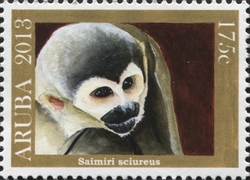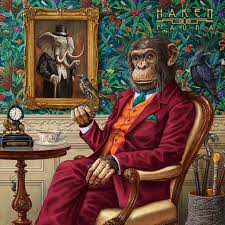Stamp: Saimiri sciureus (Aruba 2013)
Saimiri sciureus (Aruba 2013)
16 December (Aruba ) within release Forest Animals goes into circulation Stamp Saimiri sciureus face value 1.75 Aruban florin
| Stamp Saimiri sciureus in catalogues | |
|---|---|
| WADP Numbering System - WNS: | WAD:AW075.13 |
Stamp is horizontal format.
Also in the issue Forest Animals:
- Stamp - Agalychnis calidryas face value 1.75;
- Stamp - Panthera onca face value 1.75;
- Stamp - Ara macao face value 1.75;
- Stamp - Ranitomega benedicta face value 1.75;
- Stamp - Saimiri sciureus face value 1.75;
- Stamp - Panthera onca face value 1.75;
- Stamp - Ramphastos sulfuratus face value 1.75;
- Stamp - Sanguinus imperator face value 1.75;
|
Data entry completed
80%
|
|
|---|---|
| Stamp Saimiri sciureus in digits | |
| Country: | Aruba |
| Date: | 2013-12-16 |
| Size: | 36 x 26 |
| Perforation: | 14 by 14 |
| Format: | Stamp |
| Face Value: | 1.75 Aruban florin |
Stamp Saimiri sciureus it reflects the thematic directions:
Mammals are any vertebrates within the class Mammalia (/məˈmeɪli.ə/ from Latin mamma "breast"), a clade of endothermic amniotes distinguished from reptiles (including birds) by the possession of a neocortex (a region of the brain), hair, three middle ear bones and mammary glands. All female mammals nurse their young with milk, secreted from the mammary glands. Mammals include the largest animals on the planet, the great whales. The basic body type is a terrestrial quadruped, but some mammals are adapted for life at sea, in the air, in trees, underground or on two legs. The largest group of mammals, the placentals, have a placenta, which enables the feeding of the fetus during gestation. Mammals range in size from the 30–40 mm (1.2–1.6 in) bumblebee bat to the 30-meter (98 ft) blue whale. With the exception of the five species of monotreme (egg-laying mammals), all modern mammals give birth to live young. Most mammals, including the six most species-rich orders, belong to the placental group. The largest orders are the rodents, bats and Soricomorpha (shrews and allies). The next three biggest orders, depending on the biological classification scheme used, are the Primates (apes and monkeys), the Cetartiodactyla (whales and even-toed ungulates), and the Carnivora (cats, dogs, seals, and allies).
Fauna (pl.: faunae or faunas) is all of the animal life present in a particular region or time. The corresponding terms for plants and fungi are flora and funga, respectively. Flora, fauna, funga and other forms of life are collectively referred to as biota. Zoologists and paleontologists use fauna to refer to a typical collection of animals found in a specific time or place, e.g. the "Sonoran Desert fauna" or the "Burgess Shale fauna". Paleontologists sometimes refer to a sequence of faunal stages, which is a series of rocks all containing similar fossils. The study of animals of a particular region is called faunistics.


